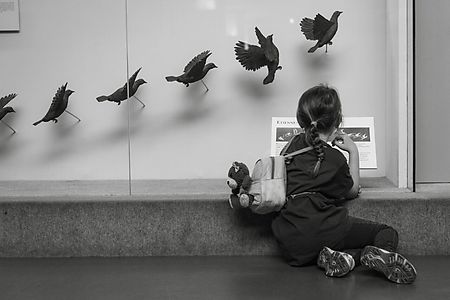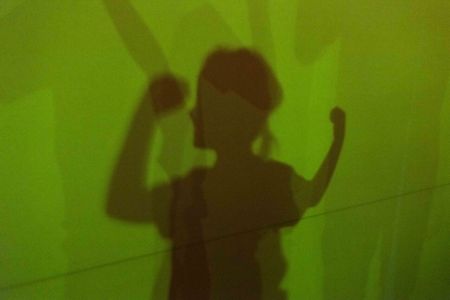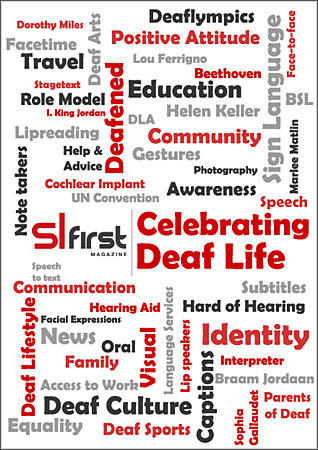Day Trips13th September 2015
Deaf access at the London Science Museum
With different levels of Deaf access throughout, the visiting experience itself shows how accessibility is changing
 My love of science was prompted by my childhood fascination with aliens and unexplained phenomena. One of my biggest fears was that I might spontaneously combust! I thought I would be found as a pile of ashes in my otherwise unscathed bedroom one day, just like this woman in a grainy black and white photo I’d seen in a book. My dubious diet of 1980's B-movies and 1950's sci-fi literature fuelled my imagination to wonder about how life developed on earth, whether aliens exist or space travel to distant galaxies is possible. I wanted to take things apart and find out how they worked. Unfortunately, I couldn’t always put them back together again.
My love of science was prompted by my childhood fascination with aliens and unexplained phenomena. One of my biggest fears was that I might spontaneously combust! I thought I would be found as a pile of ashes in my otherwise unscathed bedroom one day, just like this woman in a grainy black and white photo I’d seen in a book. My dubious diet of 1980's B-movies and 1950's sci-fi literature fuelled my imagination to wonder about how life developed on earth, whether aliens exist or space travel to distant galaxies is possible. I wanted to take things apart and find out how they worked. Unfortunately, I couldn’t always put them back together again.
 Perhaps I was lucky to have great science teachers in high school, but the endless questions that science poses us really engaged me. The more I studied science, the more I realised how little we actually know. Yet every single thing has a story to tell and many questions for us to ask, from the biggest sun in a far away galaxy, to the smallest subatomic particle. The very act of trying to measure something, changes it. Some things remain elusively out of grasp. We can dance forever in photons and marvel at the stars and the deepest secrets of the human brain. With every layer of science that we expose and look at, we find even more wonders in the layer beneath. I will never cease to be amazed by the idea that I am built from stardust and one day I will be stardust again.
Perhaps I was lucky to have great science teachers in high school, but the endless questions that science poses us really engaged me. The more I studied science, the more I realised how little we actually know. Yet every single thing has a story to tell and many questions for us to ask, from the biggest sun in a far away galaxy, to the smallest subatomic particle. The very act of trying to measure something, changes it. Some things remain elusively out of grasp. We can dance forever in photons and marvel at the stars and the deepest secrets of the human brain. With every layer of science that we expose and look at, we find even more wonders in the layer beneath. I will never cease to be amazed by the idea that I am built from stardust and one day I will be stardust again.
 I was very excited to visit the Science Museum in London with a friend and her children. Seven stories high, a quarter of a mile long and with free entry, the Science Museum is a real treasure. There are many permanent and special temporary exhibitions, plenty of interactive activities for children and grown ups alike, as well as workshops and talks. Every section has objects big and small, representing so many different areas of science and engineering. They tell the stories of early scientists whose work has laid the foundations for the technology we live with today, and discusses the newest ideas and inventions, starting a conversation about what the future might hold for us. Science isn’t just about the physical world or universe around us, but is closely linked to how we developed as a society and how history shapes the way that we live today.
I was very excited to visit the Science Museum in London with a friend and her children. Seven stories high, a quarter of a mile long and with free entry, the Science Museum is a real treasure. There are many permanent and special temporary exhibitions, plenty of interactive activities for children and grown ups alike, as well as workshops and talks. Every section has objects big and small, representing so many different areas of science and engineering. They tell the stories of early scientists whose work has laid the foundations for the technology we live with today, and discusses the newest ideas and inventions, starting a conversation about what the future might hold for us. Science isn’t just about the physical world or universe around us, but is closely linked to how we developed as a society and how history shapes the way that we live today.
 I was interested to see how accessible the Science Museum is for Deaf and Hard of Hearing people. There’s nothing more frustrating than being interested in a topic but being confronted by a video that I can’t hear, or a talk that I can’t follow. Much of the museum consists of objects on display with images and written information to provide context and understanding of what you are looking at. I thought that most displays were fairly easy to understand, and were not too long. However, there are a number of displays that have videos built in or information coming from speakers that were not subtitled or translated into BSL.
I was interested to see how accessible the Science Museum is for Deaf and Hard of Hearing people. There’s nothing more frustrating than being interested in a topic but being confronted by a video that I can’t hear, or a talk that I can’t follow. Much of the museum consists of objects on display with images and written information to provide context and understanding of what you are looking at. I thought that most displays were fairly easy to understand, and were not too long. However, there are a number of displays that have videos built in or information coming from speakers that were not subtitled or translated into BSL.




I was pleased to see that in the newer sections such as ‘Information Age’ the videos were subtitled and some also had BSL translation built into the corner. I also found the acoustics and existence of hearing loops much better in these areas. Thanks to my cochlear implant, I can now hear through headphones on the T switch and the sound quality was great. I was able to listen to people talking about what life was like as scientists and code breakers in the war, it really brought it to life for me in a way that hasn’t been accessible to me before.


 The interactive areas were bright and colourful, if lacking in space a little. They were great for engaging the children with understanding how science can be fun as well as relevant to day to day life. Most importantly, they are highly visual and provide the opportunity to experience science hands on and burn off a little energy in the process.
The interactive areas were bright and colourful, if lacking in space a little. They were great for engaging the children with understanding how science can be fun as well as relevant to day to day life. Most importantly, they are highly visual and provide the opportunity to experience science hands on and burn off a little energy in the process.

Probably unknown to many people, the Science Museum website has a number of BSL videos explaining some of the exhibits in the museum. They have some fascinating videos about historical medical implements and a series of videos about climate change where you can click the button to show the BSL translation. Explore the site for more videos and information: http://www.sciencemuseum.org.uk/onlinestuff/bsl_content.aspx and
http://www.sciencemuseum.org.uk/onlinestuff/BSL_content/BSL_climate_science.aspx
 The older sections of the museum were the least accessible. Space is looking rather dated now, with videos that I couldn’t hear since the acoustics were bad and the loops were ineffective. Especially in the summer holidays, the museum is extremely busy and it isn’t always possible to get as close to the displays as you’d like, nor to find the right spot to stand for a loop system. I attended a talk all about explosions. It was aimed at children and was very well presented, visual and fun and with good quality sound through the speakers. However, I did wonder how I would have accessed it if I didn’t have my cochlear implant. I wouldn’t have been able to follow it before, and I still missed parts where I lost sight of the speaker and couldn't lip read.
The older sections of the museum were the least accessible. Space is looking rather dated now, with videos that I couldn’t hear since the acoustics were bad and the loops were ineffective. Especially in the summer holidays, the museum is extremely busy and it isn’t always possible to get as close to the displays as you’d like, nor to find the right spot to stand for a loop system. I attended a talk all about explosions. It was aimed at children and was very well presented, visual and fun and with good quality sound through the speakers. However, I did wonder how I would have accessed it if I didn’t have my cochlear implant. I wouldn’t have been able to follow it before, and I still missed parts where I lost sight of the speaker and couldn't lip read.
 The Science Museum do run a number of signed events: SIGNtific Saturdays for Families (first Saturday of every month).
The Science Museum do run a number of signed events: SIGNtific Saturdays for Families (first Saturday of every month).
SIGNtific events aimed at children are presented in BSL by a talented and enthusiastic team of deaf presenters. They are all voiceover interpreted, making them appropriate for both deaf and hearing audiences. A varied programme of workshops, shows and story tellings run throughout the year. More information can be found here: http://www.sciencemuseum.org.uk/signtific
BSL Events at Lates
This programme varies from month to month and includes deaf-led tours, workshops help in BSL, talks in BSL by deaf presenters and BSL interpreted talks.
More information can be found here: http://www.sciencemuseum.org.uk/visitmuseum/plan_your_visit/lates.aspx?keywords=lates
There is not currently a firm commitment to ensuring that all future exhibitions contain BSL, and lack of funding means that it is unlikely that current exhibitions will be updated to include BSL. The Science Museum is reviewing its accessibility strategy, so we’ll have to watch this space.
There are some exhibitions and attractions within the science museum that you need to pay for, but we still filled our day and had more left to see without getting chance to do any of the paid for activities. Every single one of us really enjoyed our day at the Science Museum and could easily have gone back for more if we’d had enough time. I’d certainly recommend a visit.
Article by Natasha Hirst, Deaf Writer
posted in Entertainment / Day Trips
13th September 2015





